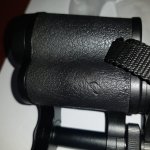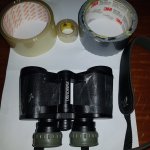PW42. Is your Habicht in the dark often? Mine was more often in the dark because I seldom used it. Darkness may have something to do with the deterioration (see the theories below by a chemist which we can support or debunk in the case of the Habicht leatherette).
Btw.. I was assigned to Africa for a few years in the company. I didn't have import tax for the Habicht so can't ship it anywhere for repair because I'd be charged $500 if it shipped back to me. I'd return to the US in a few years. Does Swarovski Habicht have international warrantee in the US? Or do I have to pay for any repair, and how much usually? Hope someone can call them and ask.
For days I'm thinking of the theories how the leatherette can degrade. I was thinking of radiation exposure, humidity, etc. Then I read the following that it could be related to the dark.
I'm developing real concerns about the black "rubberised" finishes on my 17R3. I've been having a bit of a clean out at home, and almost all of the devices that I have with similar coatings, have ...

www.dell.com
Someone asked there:
"I'm developing real concerns about the black "rubberised" finishes on my 17R3.
I've been having a bit of a clean out at home, and almost all of the devices that I have with similar coatings, have all deteriorated into a weeping sticky mess -
really unpleasant to handle. Just today I've seen this on a cordless screwdriver, a USB memory stick, an HP TabletPC battery pack (definitely not a budget item!) and a USB TV receiver.
There is a similar deterioration for some clear plastics - for example some USB cables from a few years ago had a clear coating to show the braided shielding; most of mine have been thrown out because they are so unpleasant to handle. A pair of Philips headphones had a plastic headband, that started sweating and becoming sticky, before disintegrating into pieces of plastic."
He went on to share the views from a chemist:
"
The problem is inherent in the structure of some materials. As a friend of mine (who is an industrial chemist) put it:
These rubbers are a combination of a SBS block copolymer with a low tg and a hard plastic (usually styrene) with a high tg (look it up). The various components of the mix are not completely compatible and will migrate (usually the oil plasticiser) to the surface and become sticky. Place it in full sunlight and the tack will disappear, the surface will "dry off" (oxidise) but will never go back to it's former glory. The oxidised surface marks and scratches easily. You can surface wash the parts using white spirits but the tacky soon returns. Horrible cheap injection moulded rubber. Mitigation = none - change the formula, toxicity = nil. "Real rubber" (SBR, Natural) uses different oils which are quite toxic but very compatible and rarely migrate. These compounds can't be injection moulded and are therefore (more) expensive. e.g car tyres. The reason it's normally black parts that suffer is because the formulation contains heaps of filler and re-work and without black pigment would be an unpleasant dirty greyish greeny brown. So the clever chemists add a splash of black pigment and it comes out jet black. Bootiful.
He then goes on to say: it does seem to develop in the dark ; maybe when it's exposed to the sun the surface oxidises faster and it feels less tacky. This stuff doesn't have to plasticise by migration. If the formula is balanced and good quality materials are used it remains ok. It's so easily tested for problems it's inexcusable for it to go sticky. "
In other brands of binos. Have you experienced any that are kept in the dark too but never deteriorated like the Habicht? If yes, is Swarovski using the more superior material now? Or do you have to send it to them for replacement every 5 years?











